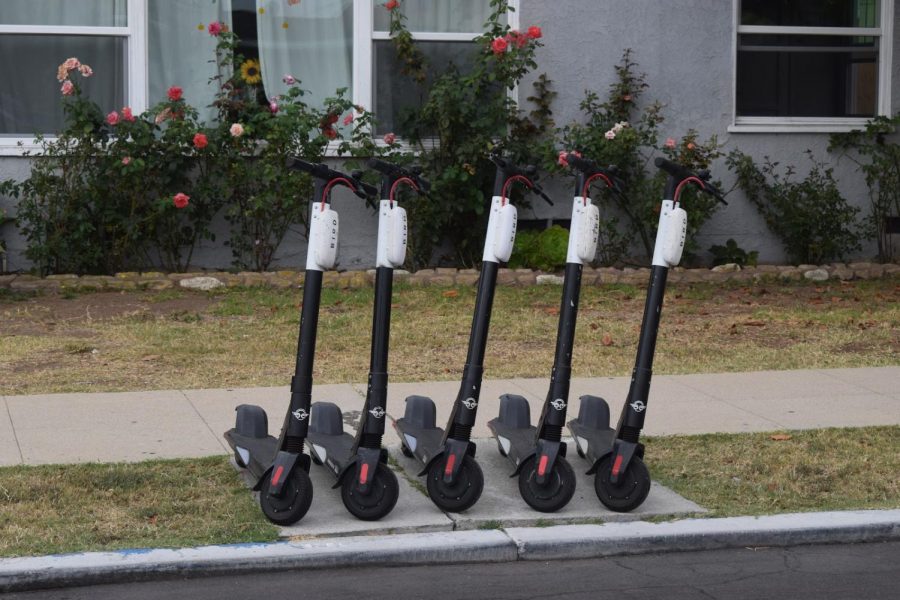San Diego State voted to restrict micro-mobility devices — both personal and pay-to-ride — based off ill-informed data and without telling the university community for months, according to a review conducted by The Daily Aztec.
In an August SDSU Newscenter article, the school said a Parking & Transportation Services report “showed a 22% increase in incidents involving bicycles, scooters and skateboards — both motorized and manual powered — on campus between 2017 and 2018.”
In analyzing the 22% statistic, there were several vague areas in the data the university used to justify its ban on electronic mobility devices.
These devices – most notably, dockless scooters such as Lime and Bird – had become a popular transportation option for students following their San Diego debut in 2017. But their popularity has been met with criticism over the safety of the devices and their practicality, as they are often found littering the streets in droves due to their dockless nature.
How the ban was passed
The ban was passed by the University Senate in a March 5 meeting, a fact the SDSU community was largely unaware of. This is because there was no formal announcement of the decision until just ahead of the 2019-2020 school year in an Aug. 19 campus-wide email.
As part of the meeting, Parking and Transportation Services Director Debbie Richeson pointed to data that shows a 22% increase in bike, scooter and skateboard incidents between Fall 2017 and Fall 2018, according to the meeting’s minutes. She said, considering the safety threat, geofencing should be instituted that would prevent certain dockless devices from being able to enter campus boundaries.
Although, when asked about the 22% increase in accidents, Richeson clarified “she can’t actually distinguish those (accidents) specifically related to motorized scooters.”
Although the data was inconclusive about the role of motorized scooters in causing accidents, the University Senate followed through with the restrictions.
Richseon said the university community was not informed of the decision sooner because the ban still needed to be worked out with the scooter companies.
What’s wrong with the data?
The 22% figure used to justify the ban was collected from a spreadsheet of all the bike, scooter and skateboard accidents reported to Calpulli.
Richeson said the data spreadsheet was obtained per request from Student Health Services. It wasn’t until she requested the report that the department labeled the scooters as motorized or not, starting in February 2019. This means the data made it impossible to conclude, in some cases, whether scooter accidents were due to motorized or manually operated devices.
In addition to not mentioning the kind of scooters that caused accidents, the report failed to label the incidents as pedestrian collisions or single-rider accidents until Richeson requested they do so.
The data lists 139 incidents between August 2017 and February 2019. Out of the 139 incidents, 17.9% of those came from scooters and 8.2% came from bicycles.
Meanwhile, 73.9% of the accidents reported came from skateboards, another popular transportation option with students. Skateboards, unless they are motorized, are still allowed on campus.
Richeson said she did not look into the individual incidents if they were specifically related to motorized scooters.
“I didn’t go into detail with that, I was just looking at the flat number,” Richeson said. “I didn’t look to see if it was a skateboard, a scooter or bike. I just wanted to know what kind of injuries were happening on the campus.”
Richeson said safety was the main concern.
“We felt safety was the theme that went through the group,” she said. “We felt our campus is a small footprint and it can be somewhat difficult having the bikes, skateboards and scooters that are just self propelled. Bringing on this electric (device) was going to create more incidents and injury.”
A former A.S. executive who spoke on condition of anonymity worked on the board that helped to curate the micro-mobility restrictions.
They said the data was provided to the team, but safety was their top priority.
“(The incident report) was provided but I didn’t go super deep into it,” the source said. “To be honest, the committee was not on my super high-end priority.”
Framing the data
When news of the decision to ban these devices was relayed to the university community, the 22% figure was attached with no clarification of the methodology used to obtain this number. The raw data behind it was located on the University Senate webpage.
Journalism and Media Studies professor Jayla Lee specializes in research methods. She said whenever statistics are published in this way, all information available on the data should be shared.
“When reporting data, I think it’s important to be transparent about the numbers, rather than only use some of them to support a desired outcome,” Lee said. “In this case, using a percentage could make it sound like more of an increase versus just sharing the numbers from year to year.”
Lee added the university needs to be more specific on the exact dates from when they collected data.
“The numbers might not look as exciting, but it is the truth,” she said.
The report shows 45 incidents on bikes, scooters and skateboards in fall 2017 compared to to 55 incidents in fall 2018. Meanwhile, there were 11 incidents in spring 2018 and 14 in spring 2019.
For scooters, there were only three incidents in the 2017-2018 school year which increased to 19 incidents in the 2018-2019 school year.
Although it is clear there was an increase in scooter accidents, the data – which was used to justify the motorized devices ban – still fails to conclude whether these accidents can be attributed to motorized or manually operated scooters.
The former A.S. executive from the board argued the best course of action would have been an exclusivity contract with just one e-scooter company. The one scooter company would give
SDSU part of its profits and the company’s devices would be subject to a set speed limit and geofenced restrictions.
This plan never passed and the school followed through with the legislation in place today.
“They obviously just decided to ban them outright,” the source said. “I see the risk in it, as someone who skates on campus. I think with almost everything the university does, the communication should have been better.”
Community and student input
Because the data compiled did not give a complete, detailed rundown of each incident, Richeson curated a team of university leaders to diagnose the issue to make the data more “robust,” she said.
This team included 12 individuals from Student Affairs, Business & Financial Affairs, Associated Students and University Relations and Development.
Of the 12 members on the team, two of them were students.
Richeson also said there was no point when a community meeting for input was proposed.
“I can’t answer why it wasn’t done,” she said. “Always looking back in retrospect you learn from how you do things. So, like I said, going forward I want to make (community input) a practice.”
Students have mixed opinions on the matter.
English junior Adan Cortes the change was weird to him.
“We still allow the regular scooters so I don’t see the point of why they did (restrict),” Cortes said. “I myself travel across campus to class, which is barely making your time or running through the courtyard. It makes it more difficult.”
Communications sophomore Ethan Cunningham said he doesn’t understand the criticism that the university should’ve solicited community input.
“I don’t think life changes at all (without electric scooters), and I do not think the school should’ve talked to the students at all,” Cunningham said. “They handled it fine.”
The future of micro-mobility
Dockless pay-to-ride’s are still extremely prevalent in San Diego despite SDSU’s decision. The ban limited scooters on campus to eight undocking stations, but most students have opted to leave their scooters just outside campus boundaries on College Area streets.
The issue spans beyond the College Area with an estimated 40,000 dockless devices around the city, devices that have resulted in countless injuries and even one death.
Dr. Bruce Appleyard is a city planning professor at SDSU. He said the school should take proactive steps to improve the safety of micro-mobilities, rather than restrict the devices altogether. This might include reducing blind spots in walkways and using the geo-fencing tech to reduce speeds.
He also said the university should view the scooter companies as a sustainability opportunity for the school.
“It’s a great opportunity for us to engage with the transportation and tech companies and leverage who we are to chart a more sustainable and livable world, especially with SDSU West coming,” Appleyard said.
Richeson chose not to comment on whether scooters would ever make a return to campus. She said any comment about the future of micro-mobility on campus would be uninformed without school input.
“That wouldn’t be my decision to make,” she said. “It would have to be a group decision of this transportation committee and, like I said, I would take it before other people as well to get the valued input we need.”
Richeson said she is forming a committee to analyze decisions like this in the future and harvest stronger community input.
Editor in Chief Bella Ross and Staff Writer Daniel Farr contributed to this story.









